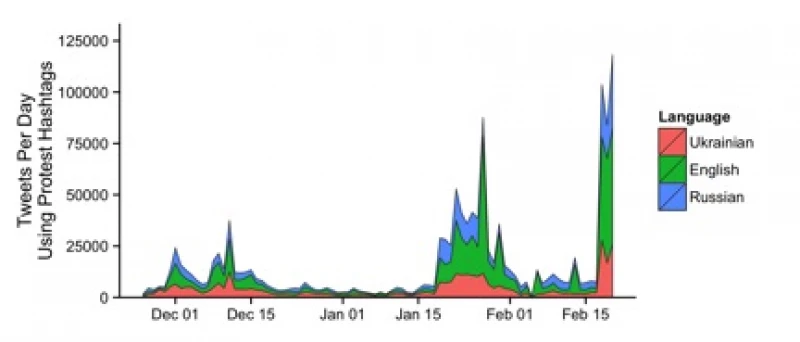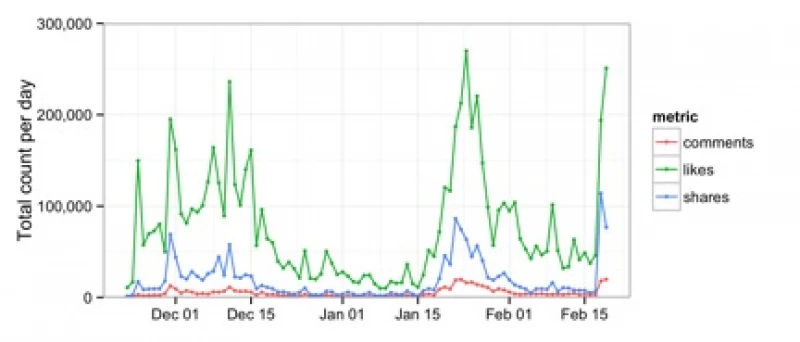- Home /
- Research /
- Reports & Analysis /
- Tweeting the Revolution: Social Media Use and the #Euromaidan Protests
Tweeting the Revolution: Social Media Use and the #Euromaidan Protests
Our analysis of Twitter and Facebook data suggests that social media continues to be a pivotal organization tool for those in Kiev and also the most relevant mechanism for disseminating and exchanging information both within Ukraine and abroad.
Credit: Wikipedia Commons
Authors
Area of Study
This article was originally published at HuffPost.
The past three days have been the most violent in recent Ukrainian history. Over 70 people are reported to have died since violence erupted on Tuesday, including following the reemergence of violence on Wednesday after the collapse of a truce between the government and protestors. Thursday, the EU formally announced that it will impose sanctions on those it deems responsible for the violence, marking the first active international intervention since the beginning of protests in November. As in other events of collective actions in the past few years, social media appears to be playing a prominent role in organizing and motivating Ukrainian protestors.
At the Social Media and Political Participation lab at NYU we have been closely following social media activity related to the protests since they began in November, collecting Twitter and Facebook data related to key protest hashtags. Our findings suggest that social media, as it has throughout these protests, continues to be a pivotal organization tool for those in Kiev and also the most relevant mechanism for disseminating and exchanging information both within Ukraine and abroad. Furthermore, as the graph below shows, activity on social media is incredibly responsive to events on the ground.

The number of tweets mentioning the main hashtag used by protestors, #Euromaidan (and its translation to Ukrainian and Russian), steadily increased over the day on February 18 as protests in the square became more violent. The activity peaked in the late evening as the police encourage women and children to evacuate, leading to the most violent period of the day. Today, we have observed a similar pattern. Activity decreased over night, to then steadily rise throughout the day as the situation became increasingly violent. The overall volume of activity is also significantly higher than at any other point in the protest. Over 250,000 tweets using the protest hashtags have been sent in the past 24 hours. Previously, the highest volume of tweets per hour was about 10,000 but today we have seen volume as high as 30,000. The graph below gives some insight into what is driving these shifts in activity.

This figure shows that the dominant language on Twitter is currently English, but that was not always the case. Earlier in the protests, language use was more evenly distributed. However, over the past few days, the proportion of tweets in English has gone up dramatically, from 44 to 53%. Our numbers do not suggest that Ukrainians are tweeting less than during other high-volume days, but instead that their numbers are being augmented by a much larger population of users from the international community. Another possible explanation for the increased activity could be a concerted effort by supporters of the protest to engage the international community, that is, Ukrainians tweeting in English to prompt this increase in participation on the part of those outside the country. Perhaps the images of violence coming out of Kiev over the past few days are extreme enough to capture the attention of even those generally less aware of international affairs. Maybe violence, particularly in Europe, mobilizes international attention in a way that mass protest alone simply can't.
The story on Facebook is quite different, with the main EuroMaidan Facebook page operating almost entirely in Ukrainian. Facebook is more obviously being used to serve the dual purpose of spreading information and operating as a logistical tool for those on the ground. Shared documents have been distributed for people to volunteer to man shifts at hospitals, and, poignantly, to gather information on the dead and any needs their families may have. There are Facebook pages specifically established for emergencies and assisting people in getting medical care. There are calls to action, as well as specific requests. Further, there is now a page, almost entirely in English devoted to spreading information more widely. The EuroMaidanPR Facebook page bills itself as the "Facebook page of the Official International Public Relations Secretariat for Headquarters of the National Resistance in Kyiv Ukraine."
Data from the main EuroMaidan Facebook page indicates that this medium also responds, in terms of volume of activity, to events on the ground. The chart below shows numbers of likes, shares, and comments over time on the main page. It's clear that activity increases dramatically, particularly likes and shares, during major incidents such as the violence over the past couple days, as well as the brief, lower-level violence in January.

The most widely shared posts on Facebook over the past days are images of police violence, injured protestors or individuals acting bravely, such as images of medics coming in to assist the wounded, which serve as crowdsourced narratives of the events in Maidan square, and motivate the protesters to resist despite police violence. The Facebook page, however, also contains an incredible amount of information ranging from news updates, to individual accounts and experiences, links to live streams of the protests, and as mentioned above information coordinating action.
While there are obviously downsides to the massive amount of information that social media creates (it can be hard, at times, to sort through everything and to assess the accuracy of the information that is shared), we have also seen that the availability of these platforms gives protestors a loud voice internationally, independent of traditional media structures and of the government, and provides a space for organization outside of the square itself. We found similar dynamics in Turkey, particularly during periods where the mainstream media locally did not cover the protests. We did not, however, observe the level of violent conflict in Turkey that is currently happening in Ukraine. What social media has shown over the last few days, however, is its flexibility as a tool. As needed, and in response to dramatically shifting events on the ground, Twitter and Facebook have been effective means to convey messages about the violence to the international community, to organize those willing to get involved in the protests, and to coordinate resources for the injured and those in need in Maidan square.
Pablo Barberá and Megan Metzger are Ph.D. candidates in the Department of Politics at NYU and graduate fellows in the Social Media and Political Participation lab.
Follow Megan Metzger on Twitter: www.twitter.com/meganicka